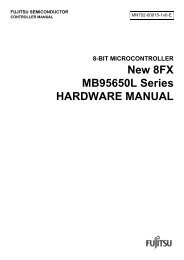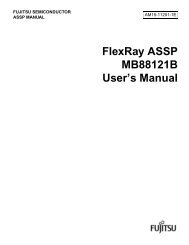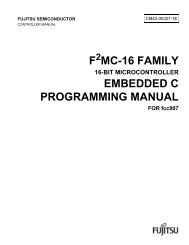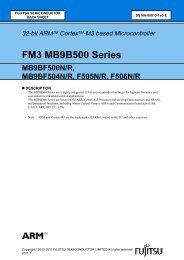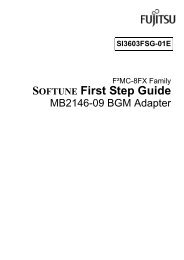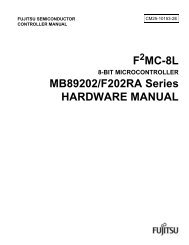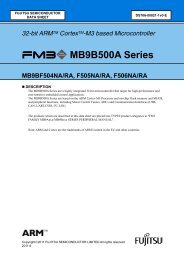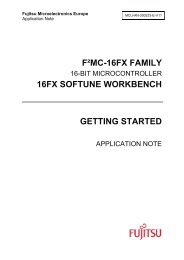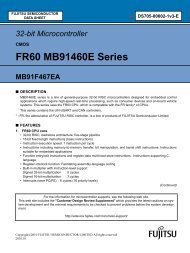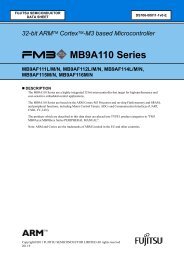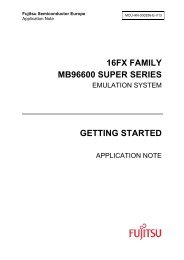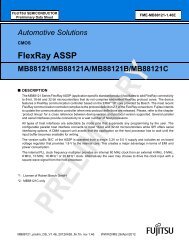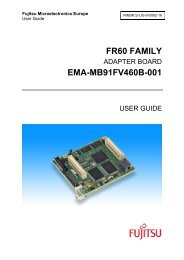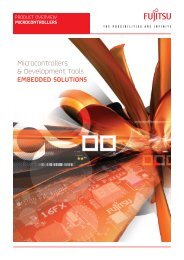J-Link / J-Trace User Guide (UM08001) - Microcontrollers
J-Link / J-Trace User Guide (UM08001) - Microcontrollers
J-Link / J-Trace User Guide (UM08001) - Microcontrollers
You also want an ePaper? Increase the reach of your titles
YUMPU automatically turns print PDFs into web optimized ePapers that Google loves.
116 CHAPTER 5 Working with J-<strong>Link</strong> and J-<strong>Trace</strong><br />
5.9 Using DCC for memory access<br />
The ARM7/9 architecture requires cooperation of the CPU to access memory when the<br />
CPU is running (not in debug mode). This means that memory can not normally be<br />
accessed while the CPU is executing the application program. The normal way to read<br />
or write memory is to halt the CPU (put it into debug mode) before accessing memory.<br />
Even if the CPU is restarted after the memory access, the real time behavior is<br />
significantly affected; halting and restarting the CPU costs typically multiple milliseconds.<br />
For this reason, most debuggers do not even allow memory access if the CPU is<br />
running.<br />
Fortunately, there is one other option: DCC (Direct communication channel) can be<br />
used to communicate with the CPU while it is executing the application program. All<br />
that is required is that the application program calls a DCC handler from time to<br />
time. This DCC handler typically requires less than 1 µs per call.<br />
The DCC handler, as well as the optional DCC abort handler, is part of the J-<strong>Link</strong> software<br />
package and can be found in the Samples\DCC\IAR directory of the package.<br />
5.9.1 What is required?<br />
• An application program on the host (typically a debugger) that uses DCC<br />
• A target application program that regularly calls the DCC handler<br />
• The supplied abort handler should be installed (optional)<br />
An application program that uses DCC is J<strong>Link</strong>.exe.<br />
5.9.2 Target DCC handler<br />
The target DCC handler is a simple C-file taking care of the communication. The function<br />
DCC_Process() needs to be called regularly from the application program or<br />
from an interrupt handler. If a RTOS is used, a good place to call the DCC handler is<br />
from the timer tick interrupt. In general, the more often the DCC handler is called,<br />
the faster memory can be accessed. On most devices, it is also possible to let the<br />
DCC generate an interrupt which can be used to call the DCC handler.<br />
5.9.3 Target DCC abort handler<br />
An optional DCC abort handler (a simple assembly file) can be included in the application.<br />
The DCC abort handler allows data aborts caused by memory reads/writes via<br />
DCC to be handled gracefully. If the data abort has been caused by the DCC communication,<br />
it returns to the instruction right after the one causing the abort, allowing<br />
the application program to continue to run. In addition to that, it allows the host to<br />
detect if a data abort occurred.<br />
In order to use the DCC abort handler, 3 things need to be done:<br />
• Place a branch to DCC_Abort at address 0x10 ("vector" used for data aborts)<br />
• Initialize the Abort-mode stack pointer to an area of at least 8 bytes of stack<br />
memory required by the handler<br />
• Add the DCC abort handler assembly file to the application<br />
J-<strong>Link</strong> / J-<strong>Trace</strong> (<strong>UM08001</strong>) © 2004-2010 SEGGER Microcontroller GmbH & Co. KG



